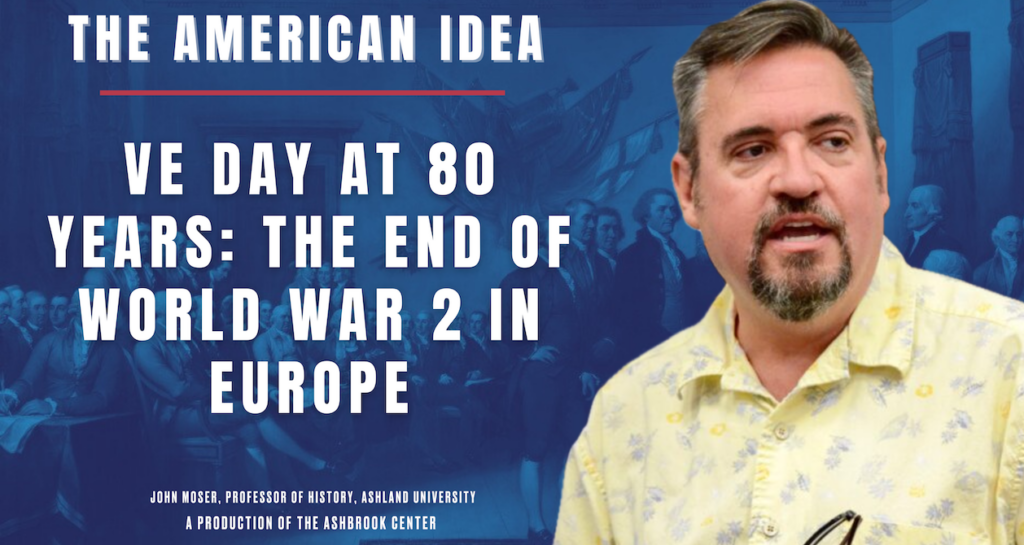VE Day at 80 Years: Looking Back on the end of WW2 in Europe
May 7, 2025

Listen and subscribe to the podcast
Join The American Idea’s Listener Email list – get news about upcoming episodes and a chance to offer questions for them, too!
When Winston Churchill declared after the Battle of El Alamein in 1942 that this was “not the end, it is not even the beginning of the end, but it is perhaps the end of the beginning,” he captured the complex reality of World War II’s progression. The true “beginning of the end” would not arrive until the summer of 1944, following the Normandy landings and subsequent Allied breakout. Even then, the path to victory remained fraught with unexpected challenges and political complications that would ultimately shape the post-war world.
The Grand Alliance: Cooperation Amid Tension
The defeat of Nazi Germany required an unprecedented alliance between ideologically opposed powers. The United States, Great Britain, and the Soviet Union maintained a fragile but effective partnership throughout the war, though significant disagreements about the post-war order simmered just beneath the surface. The question of Poland’s fate proved particularly contentious, with Stalin’s vision of a Soviet-controlled Eastern Europe clashing with Western ideals of self-determination.
This tension was dramatically illustrated during the December 1944 Battle of the Bulge. While the Allies were negotiating the post-war world’s structure, Hitler launched a surprise counteroffensive that momentarily threatened to split Allied forces. Though ultimately unsuccessful, this German push exposed both the unpredictability of warfare and the vulnerability of even overwhelming Allied advantages. It served as a stark reminder that despite the inevitability of Germany’s defeat by late 1944, the war’s conclusion would not arrive without further sacrifice.
Shaping Tomorrow’s World at Yalta
In February 1945, as Soviet forces advanced from the east and Anglo-American forces pushed from the west, the “Big Three” – Roosevelt, Churchill, and Stalin – convened at Yalta to determine Europe’s future. The decisions made during this conference would reverberate throughout the remainder of the century.
The division of Germany into occupation zones laid groundwork for what would become a decades-long split between East and West. Though initially intended to be governed collectively by an Allied control council, these zones quickly hardened into separate spheres of influence as Cold War tensions intensified. Similarly, discussions about the United Nations’ structure – particularly the Security Council’s permanent membership – established the framework for international diplomacy in the post-war era. These negotiations reflected both the optimism of the Allied powers and their naivety about future cooperation in the face of profound ideological differences.
Final Days: The Collapse of Nazi Leadership
By early 1945, Germany’s military situation had grown desperate. The Reich’s forces consisted increasingly of old men and boys pressed into service, while the Red Army advanced inexorably toward Berlin. Hitler, sequestered in his bunker beneath the capital, maintained his refusal to surrender even as his inner circle began fracturing.
Prominent Nazi figures Heinrich Himmler and Hermann Göring, recognizing the inevitability of defeat, attempted to negotiate separately with Western powers. Hitler, upon learning of these “betrayals,” stripped them of authority in his final will. The dictator’s suicide on April 30, 1945, marked the symbolic end of the Nazi regime, though formal surrender would not come until May 7. This week-long gap between Hitler’s death and Germany’s capitulation highlights the chaotic dissolution of authority in the war’s final days.
Beyond Victory: The Devastating Reality
As Allied forces advanced into German territory, they encountered evidence of atrocities that would forever define the Nazi regime. The liberation of concentration camps revealed the Holocaust’s full horror, shocking even hardened soldiers with the scale and methodical nature of the genocide. The discovery raised profound questions about collective German knowledge and complicity – questions that continue to resonate today.
Unlike the aftermath of World War I, Germany in 1945 lay physically devastated. Allied bombing campaigns and ground warfare had reduced much of the country’s infrastructure to rubble. The industrial capacity that had powered the Nazi war machine was largely destroyed, leaving the population dependent on occupiers for basic survival. This material collapse, combined with the moral bankruptcy of Nazism, created conditions fundamentally different from those following the First World War – necessitating new approaches to reconstruction and denazification.
Technology and Ideology: Seeds of a New Conflict
Germany’s technological innovations – particularly the V1 and V2 rockets – represented remarkable engineering achievements, but strategic mismanagement prevented them from meaningfully affecting the war’s outcome. Hitler’s persistent focus on offensive rather than defensive applications squandered potential advantages. Meanwhile, the Manhattan Project’s success would soon demonstrate the decisive impact of focused technological development, though its immediate consequences would unfold in the Pacific rather than European theater.
More significant for Europe’s future was the ideological division emerging even before Germany’s surrender. The optimistic assumptions of Allied cooperation that characterized the Yalta Conference quickly gave way to mutual suspicion. The Soviet Union’s establishment of friendly governments throughout its occupation zone clashed with Western democratic principles, setting the stage for a new kind of conflict. Germany’s division would become both symbol and battleground of this Cold War – a division that would persist long after the guns of World War II fell silent.
The war’s end in Europe represented not merely military victory but a profound historical inflection point. The decisions made in those final months – about occupation, punishment, reconstruction, and cooperation – would shape international relations for generations. As we mark the 80th anniversary of VE Day, we recognize both the triumph of defeating Nazism and the complex legacy that victory created – a legacy still visible in Europe’s political landscape and collective memory today.

